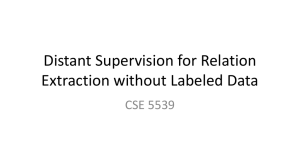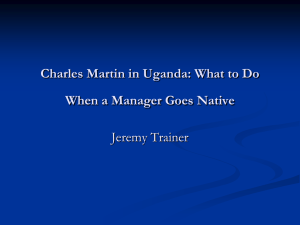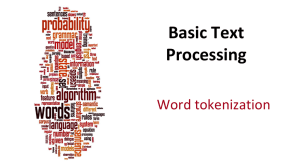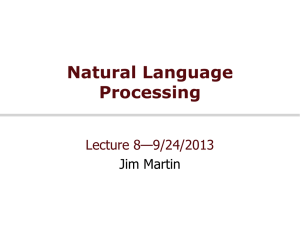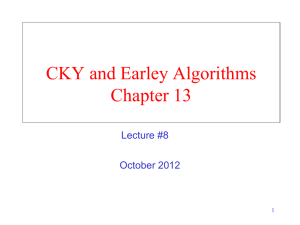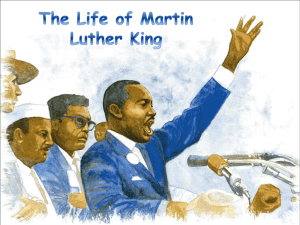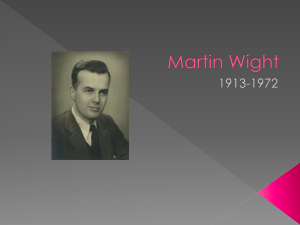lecture_05
advertisement
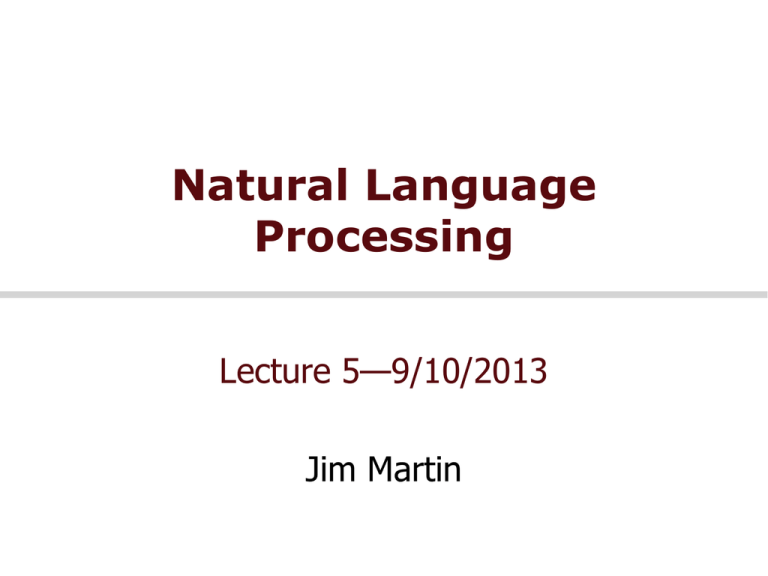
Natural Language Processing Lecture 5—9/10/2013 Jim Martin Today Minimum edit distance and Spelling Correction Dynamic programming Language modeling (N-grams) N-gram intro The chain rule Model evaluation 4/13/2015 Speech and Language Processing - Jurafsky and Martin 2 Spelling Correction We can detect spelling errors (spell check) by building an FST-based lexicon and noting any strings that are rejected. But how do I fix “graffe”? That is, how do I come up with suggested corrections? Search through all words in my lexicon Graft, craft, grail, giraffe, crafted, etc. Pick the one that’s closest to graffe But what does “closest” mean? We need a distance metric. The simplest one: minimum edit distance As in the Unix diff command 4/13/2015 Speech and Language Processing - Jurafsky and Martin 3 Edit Distance The minimum edit distance between two strings is the minimum number of editing operations Insertion Deletion Substitution that one would need to transform one string into the other 4/13/2015 Speech and Language Processing - Jurafsky and Martin 4 Note The following discussion has 2 goals 1. Learn the minimum edit distance computation and algorithm 2. Introduce dynamic programming 4/13/2015 Speech and Language Processing - Jurafsky and Martin 5 Why “Dynamic Programming” “Where did the name, dynamic programming, come from? The 1950s were not good years for mathematical research. We had a very interesting gentleman in Washington named Wilson. He was Secretary of Defense, and he actually had a pathological fear and hatred of the word, research. I’m not using the term lightly; I’m using it precisely. His face would suffuse, he would turn red, and he would get violent if people used the term, research, in his presence. You can imagine how he felt, then, about the term, mathematical. The RAND Corporation was employed by the Air Force, and the Air Force had Wilson as its boss, essentially. Hence, I felt I had to do something to shield Wilson and the Air Force from the fact that I was really doing mathematics inside the RAND Corporation. What title, what name, could I choose? In the first place I was interested in planning, in decision making, in thinking. But planning, is not a good word for various reasons. I decided therefore to use the word, “programming” I wanted to get across the idea that this was dynamic, this was multistage, this was time-varying I thought, lets kill two birds with one stone. Lets take a word that has an absolutely precise meaning, namely dynamic, in the classical physical sense. It also has a very interesting property as an adjective, and that is its impossible to use the word, dynamic, in a pejorative sense. Try thinking of some combination that will possibly give it a pejorative meaning. Its impossible. Thus, I thought dynamic programming was a good name. It was something not even a Congressman could object to. So I used it as an umbrella for my activities.” Richard Bellman, “Eye of the Hurricane: an autobiography” 1984. 4/13/2015 Speech and Language Processing - Jurafsky and Martin 6 Min Edit Example 4/13/2015 Speech and Language Processing - Jurafsky and Martin 7 Minimum Edit Distance If each operation has cost of 1 distance between these is 5 If substitutions cost 2 (Levenshtein) distance between these is 8 4/13/2015 Speech and Language Processing - Jurafsky and Martin 8 Min Edit As Search That’s all well and good but how did we find that particular (minimum) set of operations for those two strings? We can view edit distance as a search for a path (a sequence of edits) that gets us from the start string to the final string 4/13/2015 Initial state is the word we’re transforming Operators are insert, delete, substitute Goal state is the word we’re trying to get to Path cost is what we’re trying to minimize: the number of edits Speech and Language Processing - Jurafsky and Martin 9 Min Edit as Search 4/13/2015 Speech and Language Processing - Jurafsky and Martin 10 Min Edit As Search But that generates a huge search space Navigating that space in a naïve backtracking fashion would be incredibly wasteful Why? Lots of distinct paths wind up at the same state. But there is no need to keep track of the them all. We only care about the shortest path to each of those revisited states. 4/13/2015 Speech and Language Processing - Jurafsky and Martin 11 Defining Min Edit Distance For two strings S1 of len n, S2 of len m distance(i,j) or D(i,j) Is the min edit distance of S1[1..i] and S2[1..j] That is, the minimum number of edit operations need to transform the first i characters of S1 into the first j characters of S2 The edit distance of S1, S2 is D(n,m) We compute D(n,m) by computing D(i,j) for all i (0 < i < n) and j (0 < j < m) 4/13/2015 Speech and Language Processing - Jurafsky and Martin 12 Defining Min Edit Distance Base conditions: D(i,0) = i D(0,j) = j Recurrence Relation: D(i-1,j) + 1 D(i,j) = min D(i,j-1) + 1 D(i-1,j-1) + 4/13/2015 2; if S1(i) ≠ S2(j) 0; if S1(i) = S2(j) Speech and Language Processing - Jurafsky and Martin 13 Dynamic Programming A tabular computation of D(n,m) Bottom-up We compute D(i,j) for small i,j And compute larger D(i,j) based on previously computed smaller values 4/13/2015 Speech and Language Processing - Jurafsky and Martin 14 The Edit Distance Table 4/13/2015 N 9 O 8 I 7 T 6 N 5 E 4 T 3 N 2 I 1 # 0 1 2 3 4 5 6 7 8 9 # E X E C U T I O N Speech and Language Processing - Jurafsky and Martin 15 4/13/2015 N O 9 8 I 7 T 6 N E T N 5 4 3 2 I 1 # 0 # 1 E 2 X 3 E 4 C 5 U 6 T Speech and Language Processing - Jurafsky and Martin 7 I 8 O 9 N 16 4/13/2015 N 9 8 9 10 11 12 11 10 9 8 O 8 7 8 9 10 11 10 9 8 9 I 7 6 7 8 9 10 9 8 9 10 T 6 5 6 7 8 9 8 9 10 11 N 5 4 5 6 7 8 9 10 11 10 E 4 3 4 5 6 7 8 9 10 9 T 3 4 5 6 7 8 7 8 9 8 N 2 3 4 5 6 7 8 7 8 7 I 1 2 3 4 5 6 7 6 7 8 # 0 1 2 3 4 5 6 7 8 9 # E X E C U T I O N Speech and Language Processing - Jurafsky and Martin 17 Min Edit Distance Note that the result isn’t all that informative For a pair of strings we get back a single number The min number of edits to get from here to there That’s like a map routing program that tells you the distance from here to Denver but doesn’t tell you how to get there. 4/13/2015 Speech and Language Processing - Jurafsky and Martin 18 Paths Keep a back pointer Every time we fill a cell add a pointer back to the cell that was used to create it (the min cell that lead to it) To get the sequence of operations follow the backpointer from the final cell 4/13/2015 Speech and Language Processing - Jurafsky and Martin 19 Backtrace 4/13/2015 N O I 9 8 7 8 7 6 9 8 7 10 11 12 11 10 9 9 10 11 10 9 8 8 9 10 9 8 9 8 9 10 T N E T N I # 6 5 4 3 2 1 0 # 5 4 3 4 3 2 1 E 6 5 4 5 4 3 2 X 7 6 5 6 5 4 3 E 11 10 9 8 7 8 9 N 8 7 6 7 6 5 4 C 9 8 7 8 7 6 5 U 8 9 8 7 8 7 6 T Speech and Language Processing - Jurafsky and Martin 9 10 9 8 7 6 7 I 10 11 10 9 8 7 8 O 20 Adding Backtrace to MinEdit Base conditions: D(i,0) = i D(0,j) = j Recurrence Relation: D(i,j) = min ptr(i,j) 4/13/2015 D(i-1,j) + 1 D(i,j-1) + 1 D(i-1,j-1) + LEFT DOWN DIAG Case 1 Case 2 1; if S1(i) ≠ S2(j) 0; if S1(i) = S2(j) Case 3 Case 1 Case 2 Case 3 Speech and Language Processing - Jurafsky and Martin 21 Complexity Time: O(nm) Space: O(nm) Backtrace O(n+m) 4/13/2015 Speech and Language Processing - Jurafsky and Martin 22 Alignments An alignment is a 1 to 1 pairing of each element in a sequence with a corresponding element in the other sequence or with a gap... -AGGCTATCACCTGACCTCCAGGCCGA--TGCCC--TAG-CTATCAC--GACCGC--GGTCGATTTGCCCGAC 4/13/2015 Speech and Language Processing - Jurafsky and Martin 23 Weighted Edit Distance Why would we want to add weights to the minimum edit distance computation? 4/13/2015 Speech and Language Processing - Jurafsky and Martin 24 Confusion matrix 4/13/2015 Speech and Language Processing - Jurafsky and Martin 25 4/13/2015 Speech and Language Processing - Jurafsky and Martin 26 Back To Spelling Remember graffe… We can compute the score/distance between graffe and assorted candidates MS Word gives 4/13/2015 giraffe gaffe giraffes graft How does it do that? Speech and Language Processing - Jurafsky and Martin 27 DP Search In the context of language processing (and signal processing) this kind of algorithm is often referred to as a DP search 4/13/2015 Min edit distance Viterbi and Forward algorithms CKY and Earley MT decoding Speech and Language Processing - Jurafsky and Martin 28 Break Schedule has been updated to reflect the current year First homework has been posted. Due next Tuesday. Tomorrow 9/11 is the next drop date After tomorrow there is no refund on tuition/fees and a W will appear on your transcript 4/13/2015 Speech and Language Processing - Jurafsky and Martin 29 New Topic Statistical language modeling Chapter 4 4/13/2015 Speech and Language Processing - Jurafsky and Martin 30 Word Prediction Guess the next word... So I notice three guys standing on the ??? What are some of the knowledge sources you used to come up with those predictions? 4/13/2015 Speech and Language Processing - Jurafsky and Martin 31 Word Prediction We can formalize this task using what are called N-gram models N-grams are token sequences of length N -gram means “written” Our earlier example contains the following 2-grams (aka bigrams) (So I), (I notice), (notice three), (three guys), (guys standing), (standing on), (on the) Given knowledge of counts of N-grams such as these, we can guess likely next words in a sequence. 4/13/2015 32 Speech and Language Processing - Jurafsky and Martin N-Gram Models More formally, we can use knowledge of the counts of N-grams to assess the conditional probability of candidate words as the next word in a sequence. Or, we can use them to assess the probability of an entire sequence of words. Pretty much the same thing as we’ll see... 4/13/2015 Speech and Language Processing - Jurafsky and Martin 33 Applications It turns out that being able to predict the next word (or any linguistic unit) in a sequence is an extremely useful thing to be able to do. As we’ll see, it lies at the core of the following applications 4/13/2015 Automatic speech recognition Handwriting and character recognition Spelling correction Machine translation And many more Speech and Language Processing - Jurafsky and Martin 34 Counting Simple counting lies at the core of any probabilistic approach. So let’s first take a look at what we’re counting. He stepped out into the hall, was delighted to encounter a water brother. 13 tokens, 15 if we include “,” and “.” as separate tokens. Assuming we include the comma and period as tokens, how many bigrams are there? 4/13/2015 Speech and Language Processing - Jurafsky and Martin 35 Counting Not always that simple I do uh main- mainly business data processing Spoken language poses various challenges. Should we count “uh” and other fillers as tokens? What about the repetition of “mainly”? Should such doovers count twice or just once? The answers depend on the application. If we’re focusing on something like ASR to support indexing for search, then “uh” isn’t helpful (it’s not likely to occur as a query). But filled pauses are very useful in dialog management, so we might want them there Tokenization of text raises the same kinds of issues 4/13/2015 Speech and Language Processing - Jurafsky and Martin 36 Counting: Types and Tokens How about They picnicked by the pool, then lay back on the grass and looked at the stars. 18 tokens (again counting punctuation) But we might also note that “the” is used 3 times, so there are only 16 unique types (as opposed to tokens). In going forward, we’ll have occasion to focus on counting both types and tokens of both words and N-grams. 4/13/2015 Speech and Language Processing - Jurafsky and Martin 37 Counting: Corpora What happens when we look at large bodies of text instead of single utterances Google Web Crawl Crawl of 1,024,908,267,229 English tokens in Web text 13,588,391 wordform types That seems like a lot of types... After all, even large dictionaries of English have only around 500k types. Why so many here? •Numbers •Misspellings •Names •Acronyms •etc 4/13/2015 Speech and Language Processing - Jurafsky and Martin 38 Language Modeling Now that we know how to count, back to word prediction We can model the word prediction task as the ability to assess the conditional probability of a word given the previous words in the sequence P(wn|w1,w2…wn-1) We’ll call a statistical model that can assess this a Language Model 4/13/2015 Speech and Language Processing - Jurafsky and Martin 39 Language Modeling How might we go about calculating such a conditional probability? One way is to use the definition of conditional probabilities and look for counts. So to get P(the | its water is so transparent that) By definition that’s P(its water is so transparent that the) P(its water is so transparent that) We can get each of those from counts in a large corpus. 4/13/2015 Speech and Language Processing - Jurafsky and Martin 40 Very Easy Estimate How to estimate? P(the | its water is so transparent that) P(the | its water is so transparent that) = Count(its water is so transparent that the) Count(its water is so transparent that) 4/13/2015 Speech and Language Processing - Jurafsky and Martin 41 Very Easy Estimate According to Google those counts are 12000 and 19000 so the conditional probability of interest is... P(the | its water is so transparent that) = 0.63 4/13/2015 Speech and Language Processing - Jurafsky and Martin 42 Language Modeling Unfortunately, for most sequences and for most text collections we won’t get good estimates from this method. What we’re likely to get is 0. Or worse 0/0. Clearly, we’ll have to be a little more clever. Let’s first use the chain rule of probability And then apply a particularly useful independence assumption 4/13/2015 Speech and Language Processing - Jurafsky and Martin 43 The Chain Rule Recall the definition of conditional probabilities P( A^ B) P ( A | B) = Rewriting: P( B) P( A^ B) = P( A | B) P( B) For sequences... P(A,B,C,D) = P(A)P(B|A)P(C|A,B)P(D|A,B,C) In general P(x1,x2,x3,…xn) = P(x1)P(x2|x1)P(x3|x1,x2)…P(xn|x1…xn-1) 4/13/2015 Speech and Language Processing - Jurafsky and Martin 44 The Chain Rule P(its water was so transparent)= P(its)* P(water|its)* P(was|its water)* P(so|its water was)* P(transparent|its water was so) 4/13/2015 Speech and Language Processing - Jurafsky and Martin 45 Unfortunately There are still a lot of possible sequences in there In general, we’ll never be able to get enough data to compute the statistics for those longer prefixes Same problem we had for the strings themselves 4/13/2015 Speech and Language Processing - Jurafsky and Martin 46 Independence Assumption Make the simplifying assumption P(lizard|the,other,day,I,was,walking,along,an d,saw,a) = P(lizard|a) Or maybe P(lizard|the,other,day,I,was,walking,along,an d,saw,a) = P(lizard|saw,a) That is, the probability in question is to some degree independent of its earlier history. 4/13/2015 Speech and Language Processing - Jurafsky and Martin 47 Independence Assumption This particular kind of independence assumption is called a Markov assumption after the Russian mathematician Andrei Markov. 4/13/2015 Speech and Language Processing - Jurafsky and Martin 48 Markov Assumption So for each component in the product replace with the approximation (assuming a prefix of N - 1) P(wn | w ) » P(wn | w n-1 1 n-1 n-N +1 ) Bigram version P(wn | w ) » P(wn | wn-1 ) n-1 1 4/13/2015 Speech and Language Processing - Jurafsky and Martin 49 Estimating Bigram Probabilities The Maximum Likelihood Estimate (MLE) count(wi-1,wi ) P(wi | w i-1) = count(w i-1 ) 4/13/2015 Speech and Language Processing - Jurafsky and Martin 50 An Example <s> I am Sam </s> <s> Sam I am </s> <s> I do not like green eggs and ham </s> 4/13/2015 Speech and Language Processing - Jurafsky and Martin 51 Maximum Likelihood Estimates The maximum likelihood estimate of some parameter of a model M from a training set T Is the estimate that maximizes the likelihood of the training set T given the model M Suppose the word “Chinese” occurs 400 times in a corpus of a million words (Brown corpus) What is the probability that a random word from some other text from the same distribution will be “Chinese” MLE estimate is 400/1000000 = .004 This may be a bad estimate for some other corpus But it is the estimate that makes it most likely that “Chinese” will occur 400 times in a million word corpus. 4/13/2015 Speech and Language Processing - Jurafsky and Martin 52 Berkeley Restaurant Project Sentences can you tell me about any good cantonese restaurants close by mid priced thai food is what i’m looking for tell me about chez panisse can you give me a listing of the kinds of food that are available i’m looking for a good place to eat breakfast when is caffe venezia open during the day 4/13/2015 Speech and Language Processing - Jurafsky and Martin 53 Bigram Counts Out of 9222 sentences Eg. “I want” occurred 827 times 4/13/2015 Speech and Language Processing - Jurafsky and Martin 54 Bigram Probabilities Divide bigram counts by prefix unigram counts to get probabilities. 4/13/2015 Speech and Language Processing - Jurafsky and Martin 55 Bigram Estimates of Sentence Probabilities P(<s> I want english food </s>) = P(i|<s>)* P(want|I)* P(english|want)* P(food|english)* P(</s>|food)* =.000031 4/13/2015 Speech and Language Processing - Jurafsky and Martin 56 Kinds of Knowledge As crude as they are, N-gram probabilities capture a range of interesting facts about language. P(english|want) = .0011 P(chinese|want) = .0065 P(to|want) = .66 P(eat | to) = .28 Syntax P(food | to) = 0 P(want | spend) = 0 P (i | <s>) = .25 Discourse 4/13/2015 World knowledge Speech and Language Processing - Jurafsky and Martin 57 Shannon’s Method Assigning probabilities to sentences is all well and good, but it’s not terribly illuminating . A more entertaining task is to turn the model around and use it to generate random sentences that are like the sentences from which the model was derived. Generally attributed to Claude Shannon. 4/13/2015 Speech and Language Processing - Jurafsky and Martin 58 Shannon’s Method Sample a random bigram (<s>, w) according to the probability distribution over bigrams Now sample a new random bigram (w, x) according to its probability Where the prefix w matches the suffix of the first. And so on until we randomly choose a (y, </s>) Then string the words together <s> I I want want to to eat eat Chinese Chinese food food </s> 4/13/2015 Speech and Language Processing - Jurafsky and Martin 59 Shakespeare 4/13/2015 Speech and Language Processing - Jurafsky and Martin 60 Shakespeare as a Corpus N=884,647 tokens, V=29,066 Shakespeare produced 300,000 bigram types out of V2= 844 million possible bigrams... So, 99.96% of the possible bigrams were never seen (have zero entries in the table) This is the biggest problem in language modeling; we’ll come back to it. Quadrigrams are worse: What's coming out looks like Shakespeare because it is Shakespeare 4/13/2015 Speech and Language Processing - Jurafsky and Martin 61 The Wall Street Journal is Not Shakespeare 4/13/2015 Speech and Language Processing - Jurafsky and Martin 62 Next Time We need a more formal way to assessing how good a model is Better than just looking at the generated strings More practical and advanced issues 4/13/2015 Speech and Language Processing - Jurafsky and Martin 63 Evaluating N-Gram Models Best evaluation for a language model Put model A into an application For example, a speech recognizer Evaluate the performance of the application with model A Put model B into the application and evaluate Compare performance of the application with the two models Extrinsic evaluation 4/13/2015 Speech and Language Processing - Jurafsky and Martin 64 Difficulty of extrinsic (in-vivo) evaluation of N-gram models Extrinsic evaluation This is really time-consuming Can take days to run an experiment So As a temporary solution, in order to run experiments To evaluate N-grams we often use an intrinsic evaluation, an approximation called perplexity But perplexity is a poor approximation unless the test data looks just like the training data So is generally only useful in pilot experiments (generally is not sufficient to publish) But is helpful to think about. 4/13/2015 Speech and Language Processing - Jurafsky and Martin 65 Model Evaluation How do we know if our models are any good? And in particular, how do we know if one model is better than another. Well Shannon’s game gives us an intuition. The generated texts from the higher order models sure look better. That is, they sound more like the text the model was obtained from. The generated texts from the WSJ and Shakespeare models look different That is, they look like they’re based on different underlying models. But what does that mean? Can we make that notion operational? 4/13/2015 Speech and Language Processing - Jurafsky and Martin 66 Evaluation Standard method Train parameters of our model on a training set. Look at the models performance on some new data This is exactly what happens in the real world; we want to know how our model performs on data we haven’t seen So use a test set. A dataset which is different than our training set, but is drawn from the same source Then we need an evaluation metric to tell us how well our model is doing on the test set. One such metric is perplexity 4/13/2015 Speech and Language Processing - Jurafsky and Martin 67 But First But once we start looking at test data, we’ll run into words that we haven’t seen before (pretty much regardless of how much training data you have. With an Open Vocabulary task Create an unknown word token <UNK> Training of <UNK> probabilities Create a fixed lexicon L, of size V From a dictionary or A subset of terms from the training set At text normalization phase, any training word not in L changed to <UNK> Now we count that like a normal word At test time Use UNK counts for any word not in training 4/13/2015 Speech and Language Processing - Jurafsky and Martin 68 Perplexity The intuition behind perplexity as a measure is the notion of surprise. How surprised is the language model when it sees the test set? Where surprise is a measure of... Gee, I didn’t see that coming... The more surprised the model is, the lower the probability it assigned to the test set The higher the probability, the less surprised it was 4/13/2015 Speech and Language Processing - Jurafsky and Martin 69 Perplexity Perplexity is the probability of a test set (assigned by the language model), as normalized by the number of words: Chain rule: For bigrams: Minimizing perplexity is the same as maximizing probability The best language model is one that best predicts an unseen test set 4/13/2015 Speech and Language Processing - Jurafsky and Martin 70 Lower perplexity means a better model Training 38 million words, test 1.5 million words, WSJ 4/13/2015 Speech and Language Processing - Jurafsky and Martin 71 Practical Issues We do everything in log space Avoid underflow (also adding is faster than multiplying) 4/13/2015 Speech and Language Processing - Jurafsky and Martin 72 Google N-Gram Release 4/13/2015 Speech and Language Processing - Jurafsky and Martin 73 Google N-Gram Release serve serve serve serve serve serve serve serve serve serve 4/13/2015 as as as as as as as as as as the the the the the the the the the the incoming 92 incubator 99 independent 794 index 223 indication 72 indicator 120 indicators 45 indispensable 111 indispensible 40 individual 234 Speech and Language Processing - Jurafsky and Martin 74 Google Caveat Remember the lesson about test sets and training sets... Test sets should be similar to the training set (drawn from the same distribution) for the probabilities to be meaningful. So... The Google corpus is fine if your application deals with arbitrary English text on the Web. If not then a smaller domain specific corpus is likely to yield better results. 4/13/2015 Speech and Language Processing - Jurafsky and Martin 75 Next Time More language modeling Smoothing and backoff 4/13/2015 Speech and Language Processing - Jurafsky and Martin 76
